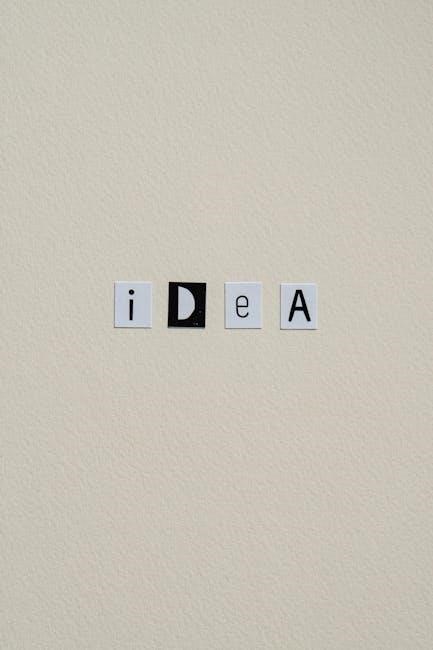Compound word worksheets are educational tools designed to help students learn and practice compound words through engaging activities. They make language learning interactive and fun for all ages.
Definition and Purpose of Compound Word Worksheets
Compound word worksheets are educational resources designed to help students understand and work with compound words. These worksheets typically include activities like matching exercises, word searches, and fill-in-the-blank tasks. They are created to make learning engaging and interactive, allowing students to explore how two smaller words combine to form a new word with a unique meaning. The primary purpose of these worksheets is to enhance vocabulary, improve spelling skills, and foster a deeper understanding of language structure. They are particularly useful for young learners, as they provide a hands-on approach to mastering compound words in a fun and structured way.
Importance of Learning Compound Words
Learning compound words is essential for building a strong foundation in language skills. Compound words expand vocabulary, enhance spelling abilities, and improve reading comprehension. By understanding how smaller words combine to create new meanings, students gain insight into the structure of language. This skill also fosters creativity and critical thinking, as learners explore how words can merge to form entirely new concepts. Additionally, compound words are common in daily communication, making their recognition and use crucial for effective expression. Worksheets dedicated to compound words provide a structured and engaging way to practice these skills, ensuring students can identify, spell, and use compound words confidently in their writing and speech.
Benefits of Using Worksheets for Compound Word Practice

Compound word worksheets offer an interactive and engaging way to practice identifying and creating compound words. They provide a structured approach to learning, making it easier for students to grasp the concept. Worksheets often include a variety of activities, such as word searches, crosswords, and fill-in-the-blank exercises, which cater to different learning styles. These tools help improve spelling, recognition, and understanding of compound words. Additionally, worksheets allow students to practice at their own pace, reinforcing their learning. They are also a great resource for teachers to assess progress and provide targeted support. Overall, compound word worksheets make learning fun and effective, ensuring students master this essential language skill. They are versatile and suitable for learners of all ages, from kindergarten to middle school.

Types of Compound Words

Compound words are categorized into closed, hyphenated, and open types, each formed differently but serving the same purpose of combining words into a new meaningful expression.
Closed Compound Words
Closed compound words are formed when two words are written together without spaces or hyphens, creating a new word. Examples include toothbrush, firefly, and bookshelf. These words are commonly used in everyday language and are essential for vocabulary development. In compound word worksheets, closed compounds are often highlighted to help students recognize and spell them correctly. Activities such as matching exercises and fill-in-the-blank tasks are used to reinforce learning. Understanding closed compound words enhances reading and writing skills, making them a key focus in educational materials. Worksheets often include a variety of examples, from simple words like sunflower to more complex ones like birthday, ensuring a comprehensive understanding of this word type.
Hyphenated Compound Words
Hyphenated compound words are formed by joining two words with a hyphen, creating a single concept. Examples include mother-in-law, state-of-the-art, and check-up. These words are treated as separate entities but connected by the hyphen, which indicates their relationship. In compound word worksheets, hyphenated words are often highlighted to teach punctuation and word formation. Activities such as matching games and sentence completion help students recognize and use these words correctly. Hyphenated compounds can be tricky, as similar phrases may be closed or open compounds instead. Worksheets often include exercises to distinguish between these forms, ensuring proper usage. Mastering hyphenated compounds enhances spelling and reading accuracy, making them a valuable focus in educational resources.
Open Compound Words
Open compound words are two separate words that work together to form a single concept but are not physically joined. Examples include post office, high school, and real estate. These words function independently but convey a specific meaning when used together. In compound word worksheets, open compounds are often highlighted to teach word recognition and vocabulary expansion. Activities like matching games and fill-in-the-blank exercises help students identify and use these words correctly. Open compounds are essential for understanding word formation and context. Worksheets often include exercises to distinguish open compounds from closed or hyphenated forms, ensuring clarity in their usage. Mastering open compound words enhances reading comprehension and writing skills, making them a key focus in educational materials.

Structure of Compound Word Worksheets
Compound word worksheets typically include activities like matching, fill-in-the-blanks, crosswords, word searches, and creating compound words from individual words. These exercises are designed to engage learners and reinforce understanding through hands-on practice.
Matching Exercises
Matching exercises in compound word worksheets are a popular activity that involves pairing two words to create a compound word. These exercises typically include a set of word cards or lists divided into two columns or sections. Students are tasked with identifying the correct pairs that form valid compound words. For example, matching “sun” with “flower” to create “sunflower.” This activity enhances vocabulary recognition, spelling skills, and the ability to think critically about word combinations. It also helps learners understand how compound words are structured and used in everyday language. Matching exercises are engaging and effective for reinforcing compound word knowledge in a fun and interactive way. They cater to visual and kinetic learners, making them a versatile tool for classroom or homeschooling environments.
Fill-in-the-Blank Activities
Fill-in-the-blank activities in compound word worksheets provide students with sentences or short contexts containing missing words. These blanks are designed to be completed by combining two separate words to form a compound word. For example, students might see: “The __________ (sun + flower)” and write “sunflower” in the blank. These exercises improve vocabulary, spelling, and the ability to recognize compound word structures. They also help students understand how compound words function within sentences. This activity is particularly effective for reinforcing learning because it requires active participation and application of knowledge. Fill-in-the-blank exercises are versatile and can be adapted to different age groups, making them a valuable tool for teaching compound words in various educational settings.
Crossword Puzzles
Crossword puzzles are an engaging and interactive way to practice compound words. These activities present a grid with clues related to compound words, requiring students to fill in the correct words horizontally or vertically. For example, a clue might be “a type of flower” with the answer “sunflower.” Crossword puzzles enhance problem-solving skills, spelling accuracy, and the ability to recognize compound words in context. They also promote critical thinking as students work to complete the puzzle. Crossword puzzles can be tailored to different difficulty levels, making them suitable for various age groups. Regular practice with crossword puzzles helps reinforce compound word knowledge and improves overall language proficiency in a fun and challenging way.
Word Search Activities
Word search activities are a fun and interactive way for students to practice identifying and spelling compound words. These exercises typically involve a grid of letters with compound words hidden horizontally, vertically, or diagonally. Students are challenged to locate and circle the words, which reinforces their ability to recognize compound words in a jumbled format. Word searches improve vocabulary retention, spelling accuracy, and visual recognition skills. They also encourage patience and attention to detail. Many compound word worksheets include themed word searches, such as seasonal or animal-related compound words, to make learning more engaging. Word search activities are particularly effective for visual learners and can be adapted to suit different age groups, making them a versatile tool for compound word practice.
Creating Compound Words from Individual Words
Creating compound words from individual words is an engaging activity that helps students understand how smaller words combine to form new meanings. Worksheets often provide two separate words, and students are tasked with merging them into a single compound word. For example, combining “book” and “shelf” to create “bookshelf.” This exercise enhances students’ ability to recognize and construct compound words, improving both vocabulary and spelling skills. It also fosters critical thinking and linguistic awareness. This activity is particularly effective for younger learners, as it introduces them to the concept of word formation in a hands-on manner. By practicing this skill, students become more confident in identifying and using compound words in their writing and speech.

How to Identify Compound Words
Compound words combine two or more words to create a new word with a unique meaning. They can be closed, hyphenated, or open, each structured differently.
Recognizing Closed Compound Words
Closed compound words are written as a single word without spaces or hyphens, combining two or more words seamlessly. Examples include “bookshelf,” “toothbrush,” and “firefly.” These words often have meanings that differ from their individual parts. To identify them, look for words that merge two familiar words into one. For instance, “sunflower” combines “sun” and “flower” to describe a specific type of plant. Closed compounds are common in everyday language and are essential for expanding vocabulary. Worksheets often highlight these words by providing exercises that require matching or filling in the blanks with correct closed compounds, helping learners recognize and use them effectively in sentences.
Identifying Hyphenated Compound Words
Hyphenated compound words are formed by joining two or more words with a hyphen, creating a single concept. Examples include “state-of-the-art,” “mother-in-law,” and “well-known.” These words act as adjectives or nouns, and the hyphen connects the words to show their relationship; To identify them, look for words where a hyphen links two separate words that function together as a single unit. Worksheets often include exercises that ask learners to identify and create hyphenated compounds from pairs of words. This helps in understanding their structure and usage in sentences. Recognizing hyphenated compounds improves reading comprehension and vocabulary skills, making them a valuable focus in compound word practice activities.
Understanding Open Compound Words
Open compound words are formed by two separate words used together to create a new meaning, written as one word without spaces or hyphens. Examples include “bookshelf,” “toothbrush,” and “firefly.” These words function as single units in sentences and often combine a noun and a verb or two nouns. Open compounds are common in English and are frequently used in everyday language. Worksheets for compound words often include exercises to identify and create open compounds, helping learners understand their structure and usage. Recognizing open compounds enhances vocabulary and improves reading fluency. They are a fundamental part of compound word practice, making them a key focus in educational materials for language development.

Teaching Strategies for Compound Words
Effective strategies include using visual aids, interactive games, and reinforcement exercises to engage students and enhance compound word recognition and creation skills.
Using Visual Aids
Visual aids are a powerful tool for teaching compound words, as they help students connect words with meanings. Flashcards, charts, and diagrams can break down compound words into their component parts, making them easier to understand. Pictures paired with words, such as “sun” and “flower” for “sunflower,” create a clear association. Worksheets often include illustrations to reinforce learning, allowing students to visualize how two words combine to form a new word. This method is particularly effective for younger learners, as it engages both visual and linguistic skills. By integrating images and text, educators can create a engaging and effective learning environment for compound word practice.
Interactive Activities
Interactive activities are essential for engaging students in compound word practice. These activities encourage active participation and make learning enjoyable. One popular activity is creating compound words by matching word cards or puzzle pieces. Students can work in pairs or groups to combine words like “book” and “shelf” to form “bookshelf.” Another engaging exercise is role-playing, where students act out compound words for their peers to guess. Digital tools, such as interactive compound word games, can also be integrated into worksheets. These activities not only enhance understanding but also foster collaboration and problem-solving skills. By incorporating fun and dynamic exercises, educators can ensure that students remain motivated and invested in learning compound words.
Reinforcement Exercises
Reinforcement exercises are crucial for solidifying compound word knowledge. These exercises involve repetitive practice to ensure long-term retention. Flashcard drills are a popular method, where students match individual words to their compound forms. Another effective activity is writing sentences using newly learned compound words, helping students see their practical application. Word-building exercises, where students combine words to create compound terms, also reinforce understanding. Additionally, timed quizzes and games can make practice engaging while testing speed and accuracy. Regular repetition and review are key to mastering compound words, making reinforcement exercises an indispensable part of any learning strategy. These exercises ensure that students confidently apply their knowledge in various contexts.

Compound Word Worksheets for Different Age Groups
Compound word worksheets are tailored for various age groups, ensuring appropriate difficulty and engagement. Kindergarten worksheets focus on simple, visual exercises, while elementary sheets introduce more complex activities. Middle school worksheets incorporate advanced compound word challenges, preparing students for higher-level language skills. Each age-specific worksheet aligns with developmental needs, fostering progressive learning and mastery of compound words.
Worksheets for Kindergarten
Kindergarten compound word worksheets are designed to introduce young learners to basic word-building concepts. These activities often feature simple, visually engaging exercises that combine pictures with words. For example, matching games where children pair individual words like “sun” and “flower” to create “sunflower.” Fill-in-the-blank exercises with visual cues also help reinforce recognition. Worksheets may include tracing and coloring activities to develop fine motor skills while introducing compound words. The focus is on fun, interactive learning to build foundational language skills. Repetition and familiar themes, such as animals or toys, make these worksheets effective for early learners. They provide a gentle introduction to compound words, preparing kindergartners for more complex language tasks.
Worksheets for Elementary School Students
Compound word worksheets for elementary school students are designed to build upon foundational skills, introducing more complex word combinations. These exercises often include word-building activities, where students combine two words to create compound words, such as “bookshelf” or “toothbrush.” Fill-in-the-blank sentences and crossword puzzles are common, helping students understand context and spelling. Word searches and matching games are also popular, reinforcing recognition and retention. These worksheets are tailored to align with curriculum goals, providing engaging and challenging exercises. They help students develop phonetic awareness, vocabulary, and critical thinking skills. Interactive and visually appealing, these resources make learning compound words both fun and effective for elementary learners.
Worksheets for Middle School Students
Compound word worksheets for middle school students are designed to enhance vocabulary and reinforce understanding of complex word formations. These exercises often include advanced activities like creating compound words from definitions, identifying correct spellings, and analyzing word structures. Sentence completion tasks and crossword puzzles challenge students to apply compound words in context. Word searches and matching games are also included to strengthen recognition and retention. Additionally, exercises focusing on hyphenated and open compound words help refine grammatical skills. These worksheets align with middle school curriculum goals, promoting critical thinking and linguistic precision. They serve as valuable tools for improving spelling, vocabulary, and overall language proficiency in older students.

Assessment and Evaluation
Compound word worksheets are assessed through quizzes, tests, and peer reviews to evaluate understanding and progress in identifying and using compound words effectively.
Quizzes and Tests
Quizzes and tests are essential tools for assessing students’ understanding of compound words. These evaluations help teachers gauge retention and identify areas needing review. They often include multiple-choice questions, fill-in-the-blank exercises, and matching activities. Tests may also ask students to create compound words from individual words or use them in sentences. Regular quizzes ensure consistent practice and reinforce learning. Immediate feedback from tests allows students to correct mistakes and improve. Educators can use these assessments to track progress over time. Printable compound word worksheets with quizzes are widely available online, catering to diverse learning needs. By incorporating tests, educators ensure comprehensive mastery of compound words in a structured and measurable way.
Peer Review
Peer review is a collaborative learning strategy that enhances understanding of compound words. Students exchange their completed worksheets, allowing them to review and provide feedback on each other’s work. This method fosters teamwork and communication skills while reinforcing compound word recognition. Peers can highlight correct answers and suggest improvements for mistakes. Teachers often guide the process to ensure constructive feedback. Peer review promotes active learning and reduces the teacher’s workload. It also builds confidence as students explain their answers to classmates. Regular peer review sessions create a supportive environment where students learn from one another’s strengths and weaknesses. This approach complements traditional assessments like quizzes and self-assessment, offering a well-rounded learning experience.
Self-Assessment
Self-assessment is a valuable tool for students to evaluate their own progress with compound word worksheets. By reviewing their answers, students can identify areas of strength and weakness. This method encourages independent learning and accountability, as students take responsibility for understanding their mistakes. Self-assessment also provides immediate feedback, helping learners correct errors and retain compound word knowledge more effectively. Worksheets often include answer keys or examples, allowing students to compare their work and improve accuracy. Regular self-assessment builds confidence and reinforces the correct usage of compound words. It also reduces the teacher’s workload by enabling students to monitor their own progress. This practice fosters a deeper understanding of compound words and their proper application in sentences.

Common Mistakes to Avoid
Common mistakes include misidentifying compound words, incorrect spelling, and misunderstanding meanings. Students often confuse closed, hyphenated, and open compounds. Regular practice helps minimize errors and improves accuracy.
Misidentifying Compound Words
Misidentifying compound words is a common mistake, especially for learners; Many confuse closed, hyphenated, and open compounds. For example, “toothbrush” is closed, while “state-of-the-art” is hyphenated. Open compounds like “post office” are often mistaken for phrases. This error stems from lack of practice and unclear rules. To avoid it, study examples thoroughly and use visual aids like charts or flashcards. Worksheets with exercises can help reinforce distinctions. Regular practice with compound word worksheets PDFs improves recognition and reduces confusion. Encourage learners to break words into parts and identify patterns. This strategy enhances understanding and minimizes misidentification, fostering better overall comprehension of compound words.
Incorrect Spelling
Incorrect spelling is another common issue when working with compound words. Many learners struggle with spelling due to the complexity of combining two or more words. For instance, confusion arises with hyphenated words like “mother-in-law” versus closed compounds like “toothbrush.” Open compounds like “high school” are often mistaken as one word. To address this, compound word worksheets PDFs often include spelling exercises. These tools provide practice in writing compound words correctly, emphasizing proper spacing and punctuation. Regular practice helps learners memorize spellings and recognize patterns. Teachers should also highlight common errors, such as omitting hyphens or adding unnecessary spaces. Consistent practice with spelling-focused worksheets improves accuracy and confidence in writing compound words.
Misunderstanding Meanings
Misunderstanding the meanings of compound words is a frequent challenge for learners. Compound words often have meanings that differ from their individual parts, leading to confusion. For example, “toothbrush” refers to a tool for cleaning teeth, not a brush for a tooth. Worksheets for compound words PDFs often include activities to clarify meanings. Matching games and fill-in-the-blank exercises help learners connect words to their definitions. Visual aids, like diagrams or pictures, can also enhance understanding. Additionally, exercises that ask learners to create sentences using compound words in context improve comprehension. Regular practice with compound word worksheets reduces misunderstandings and helps learners grasp the unique meanings of these words. Consistent exposure ensures better retention and correct usage in daily writing and speaking.
Compound word worksheets PDFs are invaluable tools for enhancing language skills, offering engaging exercises to master compound words effectively. Consistent practice ensures better understanding and communication.
Final Thoughts on Compound Word Worksheets
Compound word worksheets PDFs are an excellent resource for learners of all ages, providing structured and engaging activities to build vocabulary and improve language skills. These worksheets cater to various learning styles and can be adapted to different educational settings, making them versatile tools for both classrooms and homeschooling. By offering a range of exercises, such as matching games, fill-in-the-blanks, and word searches, they ensure a comprehensive understanding of compound words. Parents and educators can use these worksheets to encourage regular practice, helping learners master compound words effortlessly. Consistent use of these resources fosters better reading and writing abilities, laying a strong foundation for future academic success.
Encouraging Further Practice
Consistent practice is key to mastering compound words, and compound word worksheets PDFs make it easy to extend learning beyond the classroom. Encourage learners to explore additional resources online or create personalized worksheets tailored to their interests. Setting aside a few minutes each day for practice can significantly improve their ability to identify and use compound words correctly. Parents and educators can also incorporate games and interactive activities to make practice enjoyable and engaging. By fostering a habit of regular practice, learners will become more confident and proficient in using compound words in their everyday communication. This dedication will enhance their overall language skills and open up new possibilities for creative expression.
